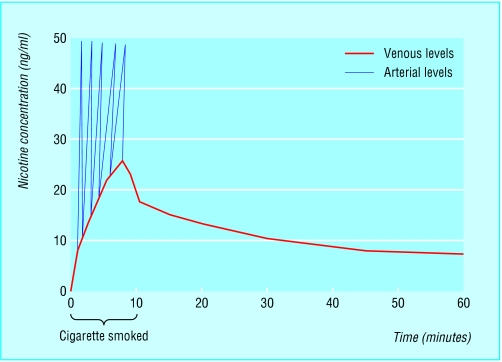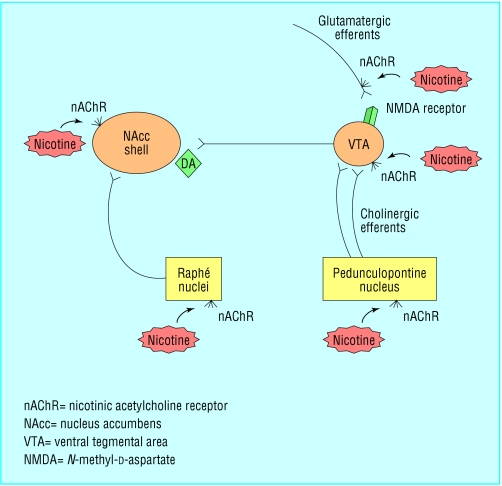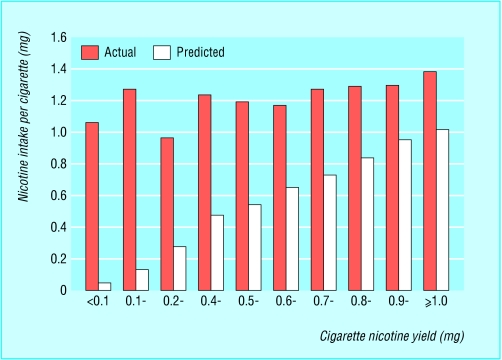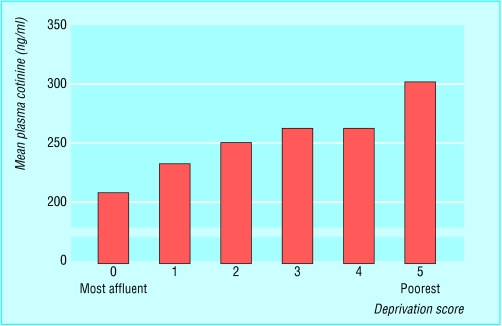For much of the 20th century, smoking was regarded as a socially learned habit and as a personal choice. It is only in the past decade or so that the fundamental role of nicotine in sustaining smoking behaviour has begun to be more widely accepted. It is now recognised that cigarette smoking is primarily a manifestation of nicotine addiction and that smokers have individually characteristic preferences for their level of nicotine intake. Smokers regulate the way they puff and inhale to achieve their desired nicotine dose.
The link with nicotine addiction does not imply that pharmacological factors drive smoking behaviour in a simple way and to the exclusion of other influences. Social, economic, personal, and political influences all play an important part in determining patterns of smoking prevalence and cessation. Although drug effects underpin the behaviour, family and wider social influences are often critical in determining who starts smoking, who gives up, and who continues.
Figure 1.
Smoking a cigarette for a beginner is a symbolic act of rebellion
Why do people start smoking?
Experimenting with smoking usually occurs in the early teenage years and is driven predominantly by psychosocial motives. For a beginner, smoking a cigarette is a symbolic act conveying messages such as, in the words of the tobacco company Philip Morris, “I am no longer my mother's child,” and “I am tough.” Children who are attracted to this adolescent assertion of perceived adulthood or rebelliousness tend to come from backgrounds that favour smoking (for example, with high levels of smoking in parents, siblings, and peers; relatively deprived neighbourhoods; schools where smoking is common). They also tend not to be succeeding according to their own or society's terms (for example, they have low self esteem, have impaired psychological wellbeing, are overweight, or are poor achievers at school).
The desired image is sufficient for the novice smoker to tolerate the aversion of the first few cigarettes, after which pharmacological factors assume much greater importance. Again in the words of Philip Morris, “as the force from the psychosocial symbolism subsides, the pharmacological effect takes over to sustain the habit.” Within a year or so of starting to smoke, children inhale the same amount of nicotine per cigarette as adults, experience craving for cigarettes when they cannot smoke, make attempts to quit, and report experiencing the whole range of nicotine withdrawal symptoms.
Physical and psychological effects of nicotine
Absorption of cigarette smoke from the lung is rapid and complete, producing with each inhalation a high concentration arterial bolus of nicotine that reaches the brain within 10-16 seconds, faster than by intravenous injection. Nicotine has a distributional half life of 15-20 minutes and a terminal half life in blood of two hours. Smokers therefore experience a pattern of repetitive and transient high blood nicotine concentrations from each cigarette, with regular hourly cigarettes needed to maintain raised concentrations, and overnight blood levels dropping to close to those of non-smokers.
Figure 2.
Arterial and venous levels of nicotine during cigarette smoking
“If it were not for the nicotine in tobacco smoke, people would be little more inclined to smoke than they are to blow bubbles”
M A H Russell, tobacco researcher, 1974
By age 20, 80% of cigarette smokers regret that they ever started, but as a result of their addiction to nicotine, many will continue to smoke for a substantial proportion of their adult lives
Nicotine has pervasive effects on brain neurochemistry. It activates nicotinic acetylcholine receptors (nAchRs), which are widely distributed in the brain, and induces the release of dopamine in the nucleus accumbens. This effect is the same as that produced by other drugs of misuse (such as amphetamines and cocaine) and is thought to be a critical feature of brain addiction mechanisms. Nicotine is a psychomotor stimulant, and in new users it speeds simple reaction time and improves performance on tasks of sustained attention. However, tolerance to many of these effects soon develops, and chronic users probably do not continue to obtain absolute improvements in performance, cognitive processing, or mood. Smokers typically report that cigarettes calm them down when they are stressed and help them to concentrate and work more effectively, but little evidence exists that nicotine provides effective self medication for adverse mood states or for coping with stress.
A plausible explanation for why smokers perceive cigarettes to be calming may come from a consideration of the effects of nicotine withdrawal. Smokers start to experience impairment of mood and performance within hours of their last cigarette, and certainly overnight. These effects are completely alleviated by smoking a cigarette. Smokers go through this process thousands of times over the course of their smoking career, and this may lead them to identify cigarettes as effective self medication, even if the effect is the negative one of withdrawal relief rather than any absolute improvement.
Figure 3.
Pathways of nicotine reinforcement and addiction. Adapted from Watkins et al. Nicotine and Tobacco Research2000;2: 19-37
Symptoms of nicotine withdrawal
Much of the intractability of cigarette smoking is thought to stem from the problems of withdrawal symptoms—particularly irritability, restlessness, feeling miserable, impaired concentration, and increased appetite—as well as from cravings for cigarettes. These withdrawal symptoms begin within hours of the last cigarette and are at maximal intensity for the first week. Most of the affective symptoms then resolve over three or four weeks, but hunger can persist for several months. Cravings, sometimes intense, can also persist for many months, especially if triggered by situational cues.
Table 1.
Effects of nicotine withdrawal
| Symptom | Duration | Incidence (%) |
|---|---|---|
| Lightheadedness |
< 48 hours |
10 |
| Sleep disturbance |
< 1 week |
25 |
| Poor concentration |
< 2 weeks |
60 |
| Craving for nicotine |
< 2 weeks |
70 |
| Irritability or aggression |
< 4 weeks |
50 |
| Depression |
< 4 weeks |
60 |
| Restlessness |
< 4 weeks |
60 |
| Increased appetite | < 10 weeks | 70 |
Social and behavioural aspects
The primary reinforcing properties of nicotine ultimately sustain smoking behaviour: in experimental models, if nicotine is removed from cigarette smoke, or nicotine's effects on the central nervous system are blocked pharmacologically, smoking eventually ceases. However, under normal conditions, the intimate coupling of behavioural rituals and sensory aspects of smoking with nicotine uptake gives ample opportunities for secondary conditioning. For a 20 a day smoker, “puff by puff” delivery of nicotine to the brain is linked to the sight of the packet, the smell of the smoke, and the scratch in the throat some 70 000 times each year. This no doubt accounts for smokers' widespread concern that if they stopped smoking they would not know what to do with their hands, and for the ability of smoking related cues to evoke strong cravings.
Figure 4.

Behavioural rituals are closely coupled with sensory aspects of smoking
Social influences also operate to modulate nicotine's effects. The direction of this influence can be to discourage smoking—as, for example, with the cultural disapproval of smoking in some communities, the expectation of non-smoking that has become the norm in professional groups, or the effects of smoke-free policies in workplaces. Other factors encourage smoking, such as being married to a smoker or being part of social networks in socially disadvantaged groups, among whom prevalence is so high as to constitute a norm.
Many experimental and clinical studies have shown that withdrawal symptoms are attributable to nicotine, as nicotine replacement (by gum, patch, spray, or lozenge) reliably attenuates the severity of withdrawal
Regulation of nicotine intake
Smokers show a strong tendency to regulate their nicotine intakes from cigarettes within quite narrow limits. They avoid intakes that are either too low (provoking withdrawal) or too high (leading to unpleasant effects of nicotine overdose). Within individuals, nicotine preferences emerge early in the smoking career and seem to be stable over time. The phenomenon of nicotine titration is responsible for the failure of intakes to decline after switching to cigarettes with low tar and nicotine yields. Compensatory puffing and inhalation, operating at a subconscious level, ensure that nicotine intakes are maintained. As nicotine and tar delivery in smoke are closely coupled, compensatory smoking likewise maintains tar intake and defeats any potential health gain from lower tar cigarettes. Similar compensatory behaviour occurs after cutting down on the number of cigarettes smoked each day; hence this popular strategy fails to deliver any meaningful health benefits.
Figure 5.
Regulation of nicotine intake: actual and predicted intake per cigarette from low tar cigarettes. Data from health survey for England, 1998
Socioeconomic status and nicotine addiction
An emerging phenomenon of the utmost significance over the past two decades has been the increasing association of continued smoking with markers of social disadvantage. Among affluent men and women in the United Kingdom, the proportion of ever smokers who have quit has more than doubled since the early 1970s, from about 25% to nearly 60%, whereas in the poorest groups the proportion has remained at around 10%. Part of the explanation for this phenomenon may be found in the growing evidence that poorer smokers tend to have higher levels of nicotine intake and are substantially more dependent on nicotine. It is evident that future progress in reducing smoking is increasingly going to have to tackle the problems posed by poverty.
Figure 6.
Nicotine intake and social deprivation. Data from health survey for England (1993, 1994, 1996)
Table 2.
Smoking behaviour and cessation
| • The natural course of cigarette smoking is typically characterised by the onset of regular smoking in adolescence, followed by repeated attempts to quit |
| • Each year about a third of adult smokers in the United Kingdom try to quit, usually unaided and typically relapsing within days |
| • In general, less than 3% of attempts to quit result in sustained (12 months') cessation, though the chances of success are slightly higher in women of childbearing age, parents of young children, and spouses of non-smokers |
Smoking as a chronic disease
Cigarette dependence is a chronic relapsing condition that for many users entails a struggle to achieve long term abstinence that extends over years or decades. Successful interventions need to tackle the interacting constellation of factors—personal, family, socioeconomic, and pharmacological—that sustain use and can act as major barriers to cessation.
Table 3.
Key points
| • Smoking usually starts as a symbolic act of rebellion or maturity |
| • By age 20, 80% of smokers regret having started to smoke |
| • Nicotine from cigarettes is highly addictive—probably because it is delivered so rapidly to the brain |
| • Smoking a cigarette, especially the first of the day, feels good mainly because it reverses the symptoms of nicotine withdrawal |
| • Most smokers who switch to low tar cigarettes or reduce the number of cigarettes they smoke continue to inhale the same amount of nicotine, and hence tar, from the cigarettes they smoke |
| • Heavy dependence on nicotine is strongly related to socioeconomic disadvantage |
| • Smoking is a chronic relapsing addictive disease |
Martin J Jarvis is professor of health psychology in the department of epidemiology and public health at University College London.
The photo of children smoking is with permission from Ralph Mortimer/Rex, and the photo of the man smoking is with permission from Alexandra Murphy/Photonica.
The ABC of smoking cessation is edited by John Britton, professor of epidemiology at the University of Nottingham in the division of epidemiology and public health at City Hospital, Nottingham.
The series will be published as a book in late spring.
Competing interests: MJJ has received speaker's honorariums from GlaxoSmithKline and Pharmacia. He is also director of an NHS funded smoking cessation clinic. See first article in this series (24 January 2004) for the series editor's competing interests.
References
- • Royal College of Physicians. Nicotine addiction in Britain. London: RCP, 2000.
- • Benowitz NL. Pharmacologic aspects of cigarette smoking and nicotine addiction. N Engl J Med 1988;319: 1318-30. [DOI] [PubMed] [Google Scholar]
- • National Institutes of Health. Risks associated with smoking cigarettes with low machine-measured yields of tar and nicotine. Bethesda, MD: Department of Health and Human Services, National Institutes of Health, National Cancer Institute, 2001. (NIH publication No 02-5074.)
- • Jarvis MJ. Patterns and predictors of unaided smoking cessation in the general population. In: Bolliger CT, Fagerstrom KO, eds. The tobacco epidemic. Basle: Karger, 1997: 151-64.







